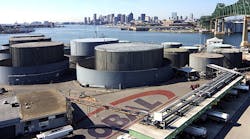THE problem with the driver shortage is that there is no one cause—which means there is no one solution.
“None of the market reactions or solutions are likely to help in the short term, so it’s likely to get worse before it gets better,” said Bob Costello, senior vice president and chief economist for the American Trucking Associations (ATA), in the conference’s economic panel presentation.
He said truck driver turnover rates are a great reflection of the driver market.
“When drivers are in high demand, they can simply change jobs—as long as they have a good driving record—for whatever reason they want,” Costello said. “Now we’ve had three consecutive years in the truckload (TL) industry with 95% or more turnover for the year. You keep a driver for 90 days and those rates drop in half. Less than truckload (LTL), of course, is much lower. They make more money and are home more often.”
Costello said the industry is short 45,000 to 50,000 drivers.
At current trends, the shortage could balloon to 240,000.
“We are in big trouble if it gets there,” he said. “Not only is our industry in trouble, but so are a lot of other industries.”
The causes of the shortage:
• Demographics/age.
He said the median employee driver age is 52 for private carriers, 50 for LTL, and 49 for all carriers and TL—versus 42 for all US workers.
“I know private fleets where their average age is over 60,” he said.
He said 47% of all US workers are female, but only 6% of truck drivers are.
“We’re missing out on a big part of the population,” he said.
• Lifestyle.
“If you go to a driving school, it’s 30-somethings and 40-somethings. They’ve been unemployed for a while and done other things, and now it’s their job of last resort.”
• Regulations.
• It’s a big responsibility and some people don’t want that.
Capacity issues
The effects of the driver shortage: it’s difficult to add capacity, and there are operational hardships, increased costs, and freight delays.
Solutions/market reactions:
• Pay is increasing. The average salary for all carriers is $54,585, with tank truck at $55,000 and refrigerated at $57,000.
“Last year, we saw many carriers put on 8%, 10%, 12%, 15% base-pay increases,” he said. “Some of those same fleets that did it last summer are doing it already this year.”
Many fleets are changing pay models where possible, offering sign-on bonuses: 48% of TL carriers are offering sign-on bonuses, followed by 33% of LTL and 33% of private fleets.
• Everyone needs to treat drivers better. Don’t hold up drivers at docks. Shippers: delivery windows are better than appointments. Shippers need to work with their customers.
• Lower interstate driving age? Maybe, but that’s years away.
• Immigration? Unlikely.
• Congestion/infrastructure.
“It adds to the problem,” he said. “Why do you want to be a truck driver when you’re sitting in traffic? Eighty-nine percent of the cost from congestion is concentrated on 12% of the miles. That tells me we can attack this, but we will need more funding in this system.”
• Productivity? LTL double 33s, maybe. TL weight or length, unlikely.
Costello said tank trucks accounted for 25.6% of all tonnage in 2013. By commodity: petroleum-based, 49.2%; chemicals, including fertilizers and cryogenics, 15.8%; everything else, 35%.
General trucking themes:
• Truck freight volumes were solid in the last three quarters of 2014. Like the broader economy, freight was softer than expected in the first quarter of this year.
• TL and LTL industries have added a little capacity in recent months, but remain well below all-time highs. Fleets will continue replacing tractors in 2015—this year should be the peak in truck sales, with a slight decline in 2016.
• Revenue per mile is picking up due to good enough demand and limited capacity.
• Fleets continue to see rising costs. Fleets are using fuel savings to pay drivers more and replace trucks.
• Many small fleets were thrown two life lines in 2014: a drop in fuel and surge in spot-market rates.
For-hire tank truck loads (both liquids and bulk commodities) increased 6% in 2012 and 6.3% in 2013, but that slowed to 2.1% last year and 2.8% in the first quarter of this year.
“As production slowed because the price of oil came down so much and knowing how big petroleum is, we went to 2.1% growth last year,” he said. “Up until 2014, this was the group that was doing the best in the trucking industry. Since oil production slowed down, it hasn’t done as well.”
In for-hire TL loads, the refrigerated sector is up 12.7% in the first quarter of this year after growing 3.7% in 2014. Dry van, tank truck, and TL intermodal are all up moderately, but flatbed is down 4% after a 3.7% decline in 2014.
Costello said the real story in trucking is capacity.
“Today, we don’t need the demand growth that we used to see for tightness in the industry to happen,” he said.
US Class 8 tractor sales were up 21.4% in 2014 and LTL was up 4%, after being down 7.8% and 1.7%, respectively, in 2013. TL tractor capacity was down 3.1% in 2014.
“I think a lot of that was right-sizing by fleets,” he said. “You had trucks parked along the fence. You’re not growing capacity in the truckload space. Class 8 tractor sales were up 21%. How can this be? You’re reducing capacity, but tractor sales are going through the roof? Yeah, because it’s all about replacement.
“We saw that tractor fleet getting old. A lot of companies were getting nickel-and-dimed to death on maintenance costs. At the same time, it was hard to recruit drivers because older equipment was breaking down. Now all of sudden you went from having carriers that could go out of business, but they can now go out and replace the truck fleet. That will continue to happen this year. It’s not an addition to capacity. It’s just that we have a lot of replacement going on.”
Chemical outlook
Martha Gilchrist Moore, senior director of policy analysis and economics for the American Chemistry Council, said 85% of the products made by her members go into manufacturing.
In the first quarter of this year, chemicals (excluding pharmaceuticals) experienced 5% year-over-year growth.
“Consumer products led the growth (up 14%), and that’s really tied to consumer spending, and that has held up,” she said. “Synthetic rubber did well (up 10%), which is tied to tires, which is tied to the vehicle market. In all, the outlook is one of strengthening. I think it will be a lot like last year, when the first quarter was down and we saw steady gains.”
She said this is a new era of US chemical competitiveness:
• Lower energy costs are encouraging energy-intensive manufacturing.
• North American ethylene producers have shifted to natural gas (ethane) from oil (naphtha) and dramatically reduced costs.
• North American producers are the second-lowest cost producers globally, after the Middle East. The Middle East advantage is diminishing with lower ethane allocations.
• Low natural gas prices are encouraging large chemical multinationals to move operations to the United States.
• A “wave” of new chemical industry investment has been announced: $140 billion.
“That represents one-third of the existing capital stock of the chemical industry, with 240 projects occurring all over the country,” she said. “Most assets are being put into the southeastern US. There are a number that plan to go into the Appalachian area to tap into the Marcellus Shale.”
The key chemical industry investment risks:
• Unpredictable energy dynamics.
• Workforce development issues. “Getting the right people with the right skills to build these facilities when they need to be built.”
• Chemical plant operations personnel, engineers, etc.
• Construction trades and labor.
• Equipment shortages/delays.
• Infrastructure bottlenecks.
• Market access/trade exposure.
• Regulatory/tax barriers.
Gilchrist Moore said the development of shale gas was “one of the most important developments in the past 50 years” because it has “changed the economic horizon for US chemical manufacturers.”
She said that at end of the day, US petrochemical competitiveness really relies on the spread between ethane, which is a natural gas-phased feedstock, and naphtha, which is a petroleum-based product.
“Most of the petrochemical sector here uses ethane, and our competitors in Europe and Asia use naphtha,” she said. “Petroleum is a globally traded commodity, but natural gas and ethane prices are regional in nature. As shale gas started to pick up in 2009, that spread started to widen.
“Through the first quarter of 2015, that spread remains historically quite high, which remains favorable to US chemical producers. As a result, US chemical producers are making tremendous investments using chemical manufacturers’ capacity to take advantage of this new competitive dynamic.
Crude exports
John Felmy, chief economist for the American Petroleum Institute, was asked by Costello if there is a realistic chance that the ban on crude exports will be lifted.
“It goes back to 1975,” he said. “It’s because everybody remembers the OPEC embargo, and everybody remembers gas lines. They connected, as though the embargo caused gas lines. But it was bad energy policy. It was price and allocation controls. We had price controls started with President Nixon and continued with President Ford and President Carter.
“What happens when you have crude exports? It adds to the potential demand and shifts the curve to the right. So it really impacts the overall market in terms of how it depends on the flatness of the supply curve. But in a dynamic sense, if suddenly we eliminate the ban and producers say, ‘Oh, there is more market here, we can make more investments, we can do a lot more,’ you can actually have a supply curve shift.
“This is not 1979. It’s 40 years later. Let’s look at the reality of the world. We’ve seen a mismatch growing between the types of crude oil we’re producing—which is light sweet crude—and the refining capacity, which, other than the East Coast, is largely focused on heavy crudes. Let’s export the expensive stuff and import the cheap stuff.” ♦
View more 2015 NTTC Annual Conference coverage>
Find the NTTC Annual Conference Report archive with articles from 2011 to present










